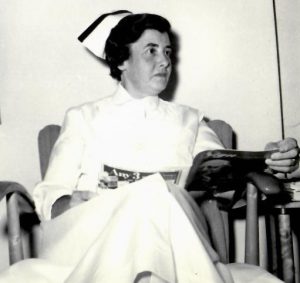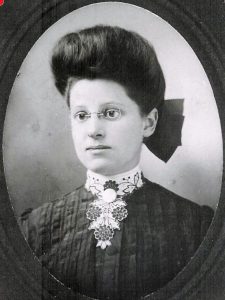My mother had never heard a whisper of this troubling disclosure. Dare I ask Nana, who lived in Florida, for further clarification? I saved my bombshell for a personal visit: “Nana, what was your mother’s cause of death?” Her eyes instantly dilated: “I have told you many times – she died of the flu.” Conversation abruptly ended.
Two years elapsed before the question resurfaced. On Memorial Day weekend in 1982, while exploring old cemeteries, my mother asked to visit Evergreen Cemetery in Marion, Massachusetts, where her grandparents were buried. My great-grandmother’s grave had gone unmarked until her husband died in 1966. Contemplating the brevity of her grandmother’s life, my mother asked, “How can we know for sure how she died?” We sought an answer at the Marion Town Clerk’s office. The clerk carried the over-size ledger from the vault, set it on the counter, and ran her finger down the column. “Here is a death record for Marion Rhodes who died in New Bedford.” “Her cause of death?” “Puerperal Septicemia.” No mention of influenza. My mother concluded halfheartedly that dying of childbed fever did not prove her grandmother had had an abortion.
Nurses could do little to break their patient’s high fever except give her strychnine and brandy.
I surmised Marion Rhodes’s place of death meant she died at St. Luke’s Hospital in New Bedford. We enlisted the help of my father, then in medical practice, to obtain the chart of Marion’s hospitalization, if one still existed. When the thick envelope arrived from medical records, my heart pounded as I deciphered the handwritten dozen pages printed from microfilm. Nurses could do little to break their patient’s high fever except give her strychnine and brandy. The chart’s final entry matter-of-factly recorded Marion’s last day: “Patient’s general condition was slightly better last night, but today suddenly turned much worse. Pulse very weak & hardly pulpable. Practically unconscious the whole day. Expired at 8 PM. September 14, 1914.” How ironic I read this on the same day, sixty-eight years later!
Perhaps intuiting I had discovered some pieces of this heart-wrenching story, Nana, near the end of her life, lamented she had no picture of her mother. Fulfilling her wish led me to Walter Rhodes’s daughter Shirley Hartley, who gave me this studio picture of Marion Sylvia at 16.
When I presented Nana with the picture, she said, “It’s my poor little mother. Aunt Belle took her to get fixed and that was the end of her.” In the gentle conversations that followed, Nana confessed that as an eavesdropping child, she listened to adult conversations when she was supposed to be upstairs sleeping. Her mother nearly died having her fifth child and was told not to have any more babies. Pregnant again within a year, Marion Rhodes went “out of her mind.”
 My Nana, Lois (Rhodes) Tobia: In her 40 years as a registered nurse, she always proudly wore her cap and uniform.
My Nana, Lois (Rhodes) Tobia: In her 40 years as a registered nurse, she always proudly wore her cap and uniform.
Among Nana’s painful but cathartic revelations the one that moved me most of all was the image of her as a child of five standing at the bedside of her dying mother in St. Luke’s Hospital. Nana resolved, there and then, to become a nurse: she never forgot the kindness of the women who tried to save her mother.
Learning the complex circumstances of my great-grandmother Marion’s death defined my watershed as a genealogist. I experienced not only the enduring power of past events but also the necessity for empathy and compassion in interpreting past lives.
Share this:

About Michael Dwyer
Michael F. Dwyer first joined NEHGS on a student membership. A Fellow of the American Society of Genealogists, he writes a bimonthly column on Lost Names in Vermont—French Canadian names that have been changed. His articles have been published in the Register, American Ancestors, The American Genealogist, The Maine Genealogist, and Rhode Island Roots, among others. The Vermont Department of Education's 2004 Teacher of the Year, Michael retired in June 2018 after 35 years of teaching subjects he loves—English and history.View all posts by Michael Dwyer →
